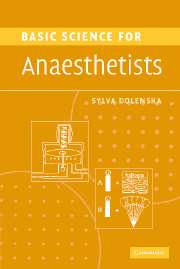Book contents
- Frontmatter
- Contents
- List of abbreviations and symbols
- List of figure captions
- Forewords
- Preface
- Preface to the second edition
- Part 1 Physics, mathematics, statistics, anaesthetic apparatus
- Part 2 Clinical measurement
- Part 3a Physiology: the cardiovascular system
- Part 3b Physiology: the respiratory system
- Part 4 Pharmacology
- Further Reading
- Index
Preface to the second edition
Published online by Cambridge University Press: 13 August 2009
- Frontmatter
- Contents
- List of abbreviations and symbols
- List of figure captions
- Forewords
- Preface
- Preface to the second edition
- Part 1 Physics, mathematics, statistics, anaesthetic apparatus
- Part 2 Clinical measurement
- Part 3a Physiology: the cardiovascular system
- Part 3b Physiology: the respiratory system
- Part 4 Pharmacology
- Further Reading
- Index
Summary
This is a revised edition of the book originally titled Anaesthetic Data Interpretation, published by Greenwich Medical Media in 2000. The new title better reflects the contents of the book.
New chapters have been added on the direct or indirect advice of Primary FRCA examiners. Ventilatory response to oxygen and ventilatory response to carbon dioxide are now core knowledge requirements, and form the basis of clinical decision making. New concepts in cardiovascular physiology, such as the end-systolic pressure–volume relationship are important to our understanding of control of cardiac function. The concept of total intravenous anaesthesia has evolved around pharmacokinetic research into how drugs behave when injected at a steady rate. Receptor types and molecular actions of anaesthetics, although may seem far removed from clinical practice, are however part of the examination syllabus, providing wider background which helps to understand how anaesthetics work. Receiver operating characteristic, an idea recently introduced in medical statistics from aviation, is a concept that will help to understand scientific articles.
Basic science does not change but technology does and some of the revisions reflect this. Technical advances in monitoring continue apace. The capnograph and the oxygen analyser are no longer the heavy cumbersome machines that were difficult to maintain. It is important to know how these machines work, in order to understand what problems may arise and to troubleshoot.
Updated chapters are based on contemporary texts and new concepts which are now contained in the syllabus. Many chapters have been improved with additions of new diagrams.
- Type
- Chapter
- Information
- Basic Science for Anaesthetists , pp. xxiii - xxivPublisher: Cambridge University PressPrint publication year: 2006



